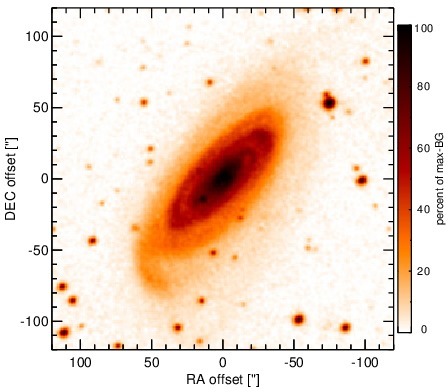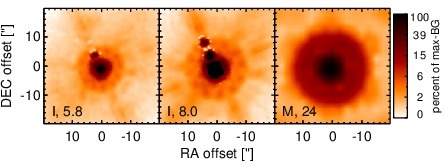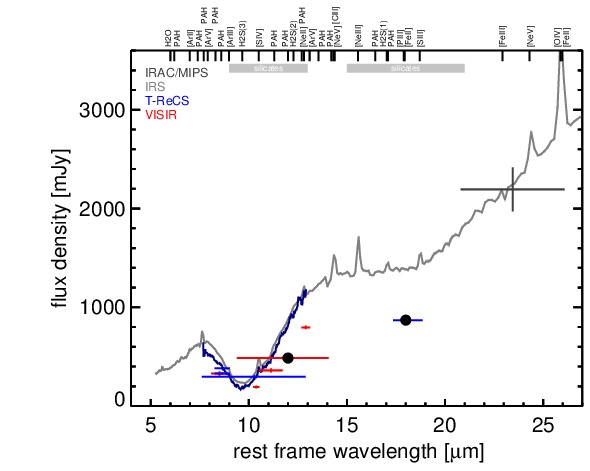Sasmirala Individual Information for NGC 3281
Description
NGC 3281 is an highly-inclined spiral galaxy at a redshift of z = 0.0107 (D ~ 52.8 Mpc) with a Sy 2 nucleus [veron-cetty_catalogue_2010] that belongs to the nine-month BAT AGN sample. It features an extended cone-like NLR with a total length of ~ 6arcsec ~ 1.5 kpc along the north-south direction (PA~ 20∘; [storchi-bergmann_ionization_1992, schmitt_hubble_2003]), while the nucleus is unresolved at radio wavelengths (e.g., [ulvestad_radio_1989, schmitt_jet_2001]). After the discovery of its MIR brightness by IRAS, NGC 3281 was imaged in N-band by [krabbe_n-band_2001] and [raban_core_2008] who detected a compact MIR nucleus. A compact nucleus does also dominate the Spitzer/IRAC and MIPS images, while faint host emission is only visible in the IRAC 8.0 μm image. The nucleus is partially saturated in the PBCD IRAC images and thus not analysed. The IRS LR staring-mode spectrum is dominated by a deep silicate 10 and 18 μm absorption without significant PAH emission and a shallow red spectral slope in νFν-space (see also [shi_9.7_2006, pereira-santaella_mid-infrared_2010, weaver_mid-infrared_2010]). The nuclear region of NGC 3281 was observed with T-ReCS in the broad N and Qa filters in 2004 [ramos_almeida_infrared_2009], and in the Si2 filter in 2008 (unpublished, to our knowledge). In addition, we imaged it with VISIR in five N-band filters in 2008, two of which were analysed already in [gandhi_resolving_2009]. In all images, a marginally resolved MIR nucleus was detected (FWHM ~ 15% larger than standard star; PA~ 170∘). The unresolved nuclear fluxes are on average ~ 20% lower than the values published in [ramos_almeida_infrared_2009] and [gandhi_resolving_2009], ~ 18% lower than the Spitzer spectrophotometry, and also systematically lower then the T-ReCS LR N-band spectrum from [gonzalez-martin_dust_2013]. The latter was first published by [sales_compton-thick_2011] and is consistent with the IRS spectrum apart from increasingly lower fluxes towards short wavelengths. These results confirm that the silicate absorption originates in the projected central < 100 pc region, or somewhere along our line of side towards it. Note that the nuclear MIR emission was further resolved with MIDI interferometric observations and was modelled as two components, one extending ¿5 pc and one unresolved dominating the emission [burtscher_diversity_2013].
- [burtscher_diversity_2013] L. Burtscher, K. Meisenheimer, K. R. W. Tristram, W. Jaffe, S. F. Hönig, R. I. Davies, M. Kishimoto, J.-U. Pott, H. Röttgering, M. Schartmann, G. Weigelt, and S. Wolf. A diversity of dusty AGN tori. data release for the VLTI/MIDI AGN large program and first results for 23 galaxies . A&A , 558 pp. 149, October 2013.
- [gandhi_resolving_2009] P. Gandhi, H. Horst, A. Smette, S. Hönig, A. Comastri, R. Gilli, C. Vignali, and W. Duschl. Resolving the mid-infrared cores of local seyferts . A&A , 502 pp. 457–472, August 2009.
- [gonzalez-martin_dust_2013] O. González-Martín, J. M. Rodríguez-Espinosa, T. Díaz-Santos, C. Packham, A. Alonso-Herrero, P. Esquej, C. Ramos Almeida, R. Mason, and C. Telesco. Dust in active galactic nuclei. mid-infrared t-ReCS/Gemini spectra using the new RedCan pipeline . A&A , 553 pp. 35, May 2013.
- [krabbe_n-band_2001] Alfred Krabbe, Torsten Böker, and Roberto Maiolino. N-band imaging of seyfert nuclei and the mid-infrared-x-ray correlation . ApJ , 557 pp. 626–636, August 2001.
- [pereira-santaella_mid-infrared_2010] Miguel Pereira-Santaella, Aleksandar M. Diamond-Stanic, Almudena Alonso-Herrero, and George H. Rieke. The mid-infrared high-ionization lines from active galactic nuclei and star-forming galaxies . ApJ , 725 pp. 2270–2280, December 2010.
- [raban_core_2008] D. Raban, B. Heijligers, H. Röttgering, K. Meisenheimer, W. Jaffe, H. U. Käufl, and T. Henning. The core flux of the brightest 10 μm galaxies in the southern sky . A&A , 484 pp. 341–345, June 2008.
- [ramos_almeida_infrared_2009] C. Ramos Almeida, N. A. Levenson, J. M. Rodríguez Espinosa, A. Alonso-Herrero, A. Asensio Ramos, J. T. Radomski, C. Packham, R. S. Fisher, and C. M. Telesco. The infrared nuclear emission of seyfert galaxies on parsec scales: Testing the clumpy torus models . ApJ , 702 pp. 1127–1149, September 2009.
- [sales_compton-thick_2011] Dinalva A. Sales, M. G. Pastoriza, R. Riffel, C. Winge, A. Rodríguez-Ardila, and A. C. Carciofi. The compton-thick seyfert 2 nucleus of NGC 3281: Torus constraints from the 9.7 μm silicate absorption . ApJ , 738 pp. 109, September 2011.
- [schmitt_hubble_2003] H. R. Schmitt, J. L. Donley, R. R. J. Antonucci, J. B. Hutchings, and A. L. Kinney. A hubble space telescope survey of extended [o III] λ5007 emission in a far-infrared selected sample of seyfert galaxies: Observations . ApJS , 148 pp. 327–352, October 2003.
- [schmitt_jet_2001] H. R. Schmitt, J. S. Ulvestad, R. R. J. Antonucci, and A. L. Kinney. Jet directions in seyfert galaxies: Radio continuum imaging data . ApJS , 132 pp. 199–209, February 2001.
- [shi_9.7_2006] Y. Shi, G. H. Rieke, D. C. Hines, V. Gorjian, M. W. Werner, K. Cleary, F. J. Low, P. S. Smith, and J. Bouwman. 9.7 μm silicate features in active galactic nuclei: New insights into unification models . ApJ , 653 pp. 127–136, December 2006.
- [storchi-bergmann_ionization_1992] Thaisa Storchi-Bergmann, Andrew S. Wilson, and Jack A. Baldwin. The ionization cone, obscured nucleus, and gaseous outflow in NGC 3281 - a prototypical seyfert 2 galaxy? . ApJ , 396 pp. 45–61, September 1992.
- [ulvestad_radio_1989] James S. Ulvestad and Andrew S. Wilson. Radio structures of seyfert galaxies. VII - extension of a distance-limited sample . ApJ , 343 pp. 659–671, August 1989.
- [veron-cetty_catalogue_2010] M.-P. Véron-Cetty and P. Véron. A catalogue of quasars and active nuclei: 13th edition . A&A , 518 pp. 10, July 2010.
- [weaver_mid-infrared_2010] K. A. Weaver, M. Meléndez, R. F. Mushotzky, S. Kraemer, K. Engle, E. Malumuth, J. Tueller, C. Markwardt, C. T. Berghea, R. P. Dudik, L. M. Winter, and L. Armus. Mid-infrared properties of the swift burst alert telescope active galactic nuclei sample of the local universe. i. emission-line diagnostics . ApJ , 716 pp. 1151–1165, June 2010.
Images

Optical image (DSS, red filter). Displayed are the central 4 arcmin with North being up and East to the left. The colour scaling is linear with white corresponding to the median background (BG) and black to the 0.01% pixels with the highest intensity.

Spitzer MIR images. Displayed are the inner 40 arcsec with North being up and East to the left. The colour scaling is logarithmic with white corresponding to median BG and black to the 0.1% pixels with the highest intensity. The label in the bottom left states instrument and central wavelength of the filter in micron (I: IRAC, M: MIPS).

Subarcsecond-resolution MIR images sorted by increasing filter central wavelength. Displayed are the inner 4 arcsec with North being up and East to the left. The colour scaling is logarithmic with white corresponding to median BG and black to the 75% of the highest intensity of all images in units of sig_bg. The inset image (where present; either bottom or top right) shows the central arcsecond of the PSF from the calibrator star, scaled to match the science target. The labels in the bottom left state instrument and filter names (C: COMICS, M: Michelle, T: T-ReCS, V: VISIR).
SEDs


MIR SED. The description of the symbols in all the SED plots (where present) is the following: Grey crosses and solid lines mark the Spitzer/IRAC, MIPS and IRS data. The colour coding of the other symbols is as follows: green for COMICS, magenta for Michelle, blue for T-ReCS and red for VISIR data. Darker-coloured solid lines mark spectra of the corresponding instrument. The black filled circles mark the nuclear 12 and 18 micron continuum emission estimate from the data (where present). The ticks on the top axis mark positions of common MIR emission lines, while the light grey horizontal bars mark wavelength ranges affected by the silicate 10 and 18 micron features.